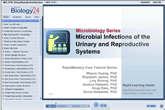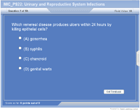| How to Learn in 24 Hours? |
|
| Need Help? |
M-F: 9am-5pm(PST):
Toll-Free: (877) RAPID-10
or 1-877-727-4310
24/7 Online Technical Support:
The Rapid Support Center
vip@rapidlearningcenter.com
Secure Online Order:

|
| Tell-A-Friend: |
Have friends taking science and math courses too? Tell them about our rapid learning system.
|
|
Urogenital and Sexually Transmitted Diseases
| Topic Review on "Title": |
- The four major components of the urinary system are the kidney, ureter, bladder, and urethra.
- Two kidneys form the urine. Two ureters conduct the urine from the kidneys to one bladder. The one bladder stores the urine, and finally the one urethra conducts the urine from the bladder to outside of the body.
- The capsule is a tough layer of connective tissue surrounding the kidney. The renal arteries and veins supply and drain blood from the kidney respectively. The urine is produced in the cortex, medulla, renal column, and pyramid. The urine is collected by papillae and directed to the minor calyx then to the major calyx then to the renal pelvis and finally to the ureter. The ureter drains the urine to the bladder where it is stored.
- The nephron is the functional unit of the Kidney that produces urine is, It is a complex structure composed of several discrete parts. Blood enters and leaves via the renal artery and renal vein. Within the Glomerular capsule the cellular portions of the blood are separated from the non-cellular portions of the body. The non-cellular portions enter the loops of Henle. Within the loops all non-waste components are returned to the blood stream, and the waste continues on to the collecting duct. Within the collecting duct, final adjustments are made to the urine before it enters the ureter for its trip to the bladder where it will stored. In addition to the removal of waste from the blood, the nephrons also help to regulate the blood pressure and ion concentrations within the blood.
- Urine flows down the ureter, through the ureteral opening and into the bladder where it is stored until about 300 ml is accumulated. Upon urination, the sphincters are relaxed and the detrusor muscle contracts to expel the urine through the internal urethral orifice, through the prostate gland, through the external urethral orifice and ultimately out of the penile urethra. Of course, on males there is a prostate gland, which is absent in females. Trouble with the prostate gland often involves swelling near the internal urethral orifice that cause small amounts of urine to be retained within the bladder and localized around the internal orifice. This retained urine causes inflammation that leads to the continued retention of more urine around the internal orifice.
- Not all of the urinary tract is sterile; the urethra has a normal complement of bacteria. The normal microbiota prevent the colonization by harmful organisms.
- UTI occur when microbes colonize regions of the urinary tract that are normally sterile. Depending on the extent of the infection, this can be very serious.
- The body tries to flush the infection out by frequent urination, but of course the microbes are expecting this and have developed defense mechanisms to counter the attach. Sometimes these defenses include the creation of biofilms.
- The vagina leads to the cervix. The cervix leads to the uterus from below while the uterine tubes (fallopian tubes) connect to the uterus from above. It is important to note that at times other than ovulation, the vagina has an acidic pH created by resident lactobacilli that feed on glycogen secreted by the walls of the vagina. At times other than ovulation, the cervix is occluded by a plug of mucus. During ovulation, the cells around the cervix, change the ratio of water and mucus thereby making the plug disappear to allow sperm to enter the uterus and ultimately the fallopian tubes.
- The cervix is the site of cervical cancer and fortunately can be reached by route of the vagina, thereby making it possible to test for metastasis with a pap smear.
- The fallopian tubes are NOT connected to the ovaries but rather are open to the body cavity above it.
- It is therefore possible for a bacteria to enter abdomen cavity via the vagina.
- This is also the path for ectopic pregnancy
- Several STI (Sexually Transmitted Diseases), viral, bacterial, protozoa are routes of infection are described.
- Nonvenereal diseases of the reproductive system including Toxic Shock Syndrome and Candidiasis.
|
| Rapid Study Kit for "Title": |
| Flash Movie |
Flash Game |
Flash Card |
| Core Concept Tutorial |
Problem Solving Drill |
Review Cheat Sheet |
 |
 |
 |
|
| "Title" Tutorial Summary : |
The urinary system is made up of organs, tubes, muscles and nerves. These work to make, store and transport urine. The urinary system includes two kidneys, two ureters, bladder, two sphincters and the urethra. From the kidneys the urine moves down two thin tubes called ureters to the bladder. The bladder stores urine until it is emptied. Urinary infections can be the result of many processes.
The sex organs are defined as: pain, prepuce, testicles, scrotum, prostate, seminal vesicles, epididymis, Cowper’s glands, vulva, vagina, cervix, uterus, Fallopian tube, ovaries, Skene’s gland and Bartholin’s glands.
|
| Tutorial Features: |
Specific Tutorial Features:
- Detailed and animated Life Cycles of pathogens.
- Unitary system structure
- Urinary system diseases
- Reproductive system structure
- Reproductive system diseases
Series Features:
- Concept map showing inter-connections of new concepts in this tutorial and those previously introduced.
- Definition slides introduce terms as they are needed.
- Visual representation of concepts
- Animated examples—of concepts are used to step wise breakdown a concepts.
- A concise summary is given at the conclusion of the tutorial.
|
| "Title" Topic List: |
Structure of urinary system
Infections of Urinary system
Structure of Female Reproductive System
Structure of Male Reproductive System
Infections of the Reproductive System
|
See all 24 lessons in Anatomy and Physiology, including concept tutorials, problem drills and cheat sheets:
Teach Yourself Microbiology Visually in 24 Hours
|



